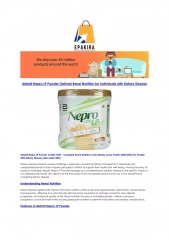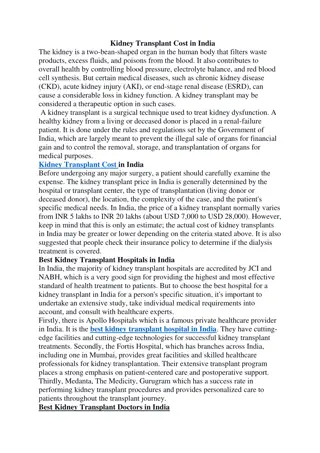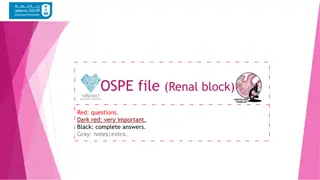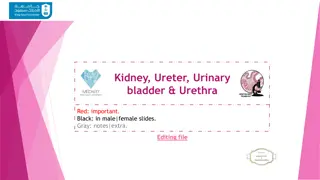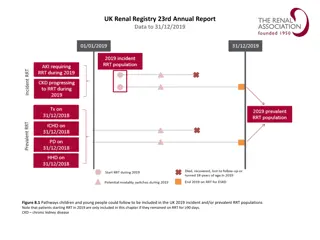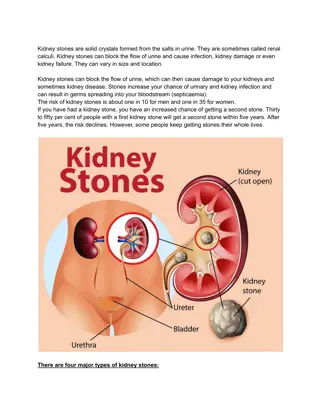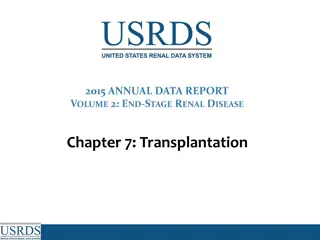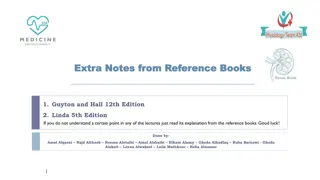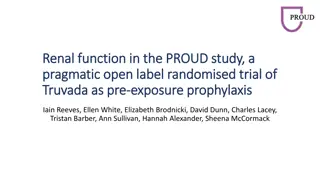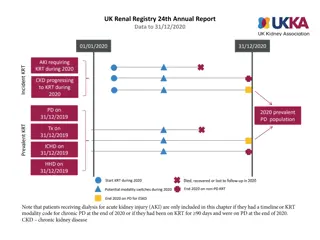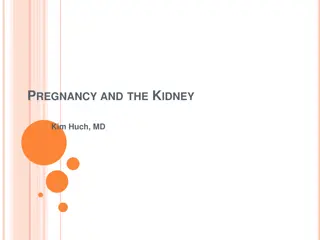Understanding Renal Function Tests and Kidney Health
Renal function tests are essential for diagnosing and monitoring kidney health. These tests assess functions like glomerular filtration, tubular reabsorption, and endocrine functions of the kidneys. Common indicators include serum urea, creatinine levels, and more. It's crucial to evaluate renal function in conditions like CKD, diabetes, hypertension, and infections. Timely assessment helps in early detection, treatment, and safe medication usage. Various tests like urine analysis, blood examination, and glomerular/tubular function tests are used to evaluate kidney function accurately.
Download Presentation

Please find below an Image/Link to download the presentation.
The content on the website is provided AS IS for your information and personal use only. It may not be sold, licensed, or shared on other websites without obtaining consent from the author. Download presentation by click this link. If you encounter any issues during the download, it is possible that the publisher has removed the file from their server.
E N D
Presentation Transcript
Excretory Formation and excretion of urine Glomerular filtration Tubular reabsorption Tubular secretion Excreting toxic substances in synergy with liver Kidney Functions Homeostatic Regulation of blood volume Regulation of blood pH Regulation of serum electrolytes; Na, K, Cl and Ca Reabsorption of essential nutrients
Endocrine Erythropoietin Renin Angiotensin system Vitamin D activation Degradation of hormones like insulin and aldosterone Metabolic Along with liver site for gluconeogenesis
To assess functional capacity of kidneys Renal function tests; Why needed? To diagnose renal impairment To assess the severity and progression of renal impairment To assess the effectiveness of treatment Monitor the safe and effective use of drugs which are excreted in the urine
Older age Family history of Chronic Kidney disease (CKD) Decreased renal mass Diabetes Mellitus (DM) Hypertension (HTN) Autoimmune disease Systemic infections Urinary tract infections (UTI) Nephrolithiasis Obstruction to the lower urinary tract Drug toxicity When should we assess renal function?
Pre-renal Any condition that results in reduced blood flow to kidneys Severe blood loss Hemolysis Causes of renal disease Renal Damage to renal tissue, glomerular basement membrane or tubules Glomerulonephritis Diabetic or hypertensive nephropathy Tubular damage due to toxic substances Post Renal Obstruction to urine outflow Ureteric or urethral stone Prostatic cancer
Renal function tests are divided into the following Urine analysis Renal function test Blood examination Glomerular Function Test Tubular Function Test
The following parameters are commonly included in assessing renal function (the normal values/reference range is mentioned) Serum Urea ( 15-45 mg/dl) Serum Creatinine (0.6 1.2 mg/dl) Serum Uric acid (males 3.5-7.2 mg/dl, females 2.6-6 mg/dl) Total protein (6.4-8.1 g/dl) Serum albumin (3.2-4.6 g/dl) Serum electrolytes Na (136-146 mEq/L) K (3.5-5.1 mEq/L) Cl (101-109 mEq/L) Phosphate (2.8-4 mg/dl) Calcium (8.8-10.2 mg/dl) Renal function test
Complete hemogram Hemoglobin total RBC MCH (Mean corpuscular hemoglobin) RBC indices MCV (Mean corpuscular volume PCV (Packed cell volume) MCHC (Mean corpuscular Hemoglobin concentration) ESR
Urine Analysis includes physical or macroscopic examination, chemical examination and microscopic examination of the sediment
Pink-Orange- Red Blue Green Red-brown-black Methylene Blue Haemoglobin Haemoglobin Pseudomonas Myoglobin Myoglobin Riboflavin Phenolpthalein Red blood cells Colour Porphyrins Homogentisic Acid Rifampicin L -DOPA Melanin Methyldopa Colour of urine depending upon it s constituents.
Specific Gravity Measured by urinometer or refractometer. It is measurement of urine density which reflects the ability of the kidney to concentrate or dilute the urine relative to the plasma from which it is filtered. Normal :- 1.001- 1.040 S.G Osmolality (mosm/kg) 1.001 100 1.010 300 1.020 800 1.025 1000 1.030 1200 1.040 1400
Specific Gravity Increase in Specific Gravity seen in Low water intake Diabetes mellitus Albuminuruia Acute nephritis. Decrease in Specific Gravity is seen in Absence of ADH Renal Tubular damage. Isosthenuria-Persistent production of fixed low Specific gravity urine isoosmolar with plasma despite variation in water intake
to measure substance in blood that are normally excreted by kidney. their level in blood increases in kidney dysfunction. Blood examination markers of renal function creatinine, urea, uric acid and electrolytes are done for routine analysis
Serum creatinine Creatinine is filtered but not reabsorbed in kidney Not increased above normal until GFR<50 ml/min The methods most widely used for serum creatinine are based on the Jaffe reaction. This reaction occurs between creatinine and the picrate ion formed in alkaline medium (sodium picrate); a red-orange solution develops which is read colorimetrically at 520 nm
Blood urea major nitrogenous end product of protein and amino acid catabolism filtered freely by the glomeruli Many renal diseases with various glomerular, tubular, interstitial or vascular damage can cause an increase in plasma urea concentration High protein diet causes significant increases in plasma urea concentrations and urinary excretion Enzymatic Berthelot Method is used for blood urea estimation
one of the latest small molecular weight proteins to be considered and used as KFT Plasma Cystatin C also seems to be subject to the tubular mechanisms for handling low molecular mass proteins, the rate of hepatic protein synthesis, and thyroid dysfunction
uric acid is the major product of the catabolism of the purine nucleosides, adenosine and guanosine Overproduction of uric acid may result from increased synthesis of purine precursors Serum Uric Acid may increase in chronic kidney disease but not sufficient to cause gout raised uric acid is a bad prognostic indicator for chronic renal disease
Both serum total protein and albumin is decreased in chronic kidney disease (CKD) due to increased proteinuria Total protein and albumin Even though proteinuria may also be seen in acute kidney disease but it usually does not alter the total protein and albumin
Serum electrolytes Sodium is decreased (hyponatremia) and potassium is increased (hyperkalemia) in chronic kidney disease (CKD) as kidney reabsorb sodium in exchange of potassium Chloride and phosphate is increased in CKD Calcium is decreased as vitamin D is deficient
CBC decreased in advanced stages of kidney disease due to deficiency of erythropoietin
Clearance of substance is defined as the volume of plasma that is cleared of that substance in unit time Inulin clearance accurately measures GFR as it is neither secreted or absorbed by the renal tubules; 51Cr- EDTA However it is not routinely done in patients. In clinical setting estimated GFR (eGFR) is more commonly used; it is calculated from serum creatinine value Clearance test
Clearance U = Concentration of the substance in urine. V = Volume of urine in ml excreted per minute. P = Concentration of the substance in plasma
Creatinine is an excretory product derived from creatine phosphate. The excretion of creatinine is rather constant & is not influenced by body metabolism or dietary factors. Creatinine is filtered by the glomeruli & only marginally secreted by the tubules Creatinine Clearance Test
GFR Significance State Grade GFR ml/mt/1.73m2 Minima damage with normal GFR 1 >90 Mild damage with slightly low GFR 2 60-89 Moderately low GFR 3 30-59 Severely low GFR 4 15-29 Kidney failure 5 <15
Cockroft Gault Formula Creatinine Clearance =(140-age)* weight in kg / S.creat.*72 (multiplied by 0.85 for females) MDRD Nomogram GFR(ml/min)=170*S.creat.-0.999 *age-0.176 * BUN-0.170 *albumin0.318 (multiplied by 0.742 if female)
Urea Clearance Test Urea is the end product of protein metabolism. After filtered by the glomeruli, it is partially reabsorbed by the renal tubules. Urea clearance is less than the GFR & it is influenced by the protein content of the diet. Urea clearance is not as sensitive as creatinine clearance
Urine Concentration Test The ability of the kidney to concentrate urine This test requires a water deprivation for 14 hrs in healthy individuals. A specific gravity of > 1.02 indicates normal concentrating power. Specific gravity of 1.008 to 1.010 is isotonic with plasma and indicates no work done by kidneys. The test should not be performed on a dehydrated patient Tests for tubular function
Vasopressin Test Urine Dilution (Water Load) Test After overnight water deprivation patient is asked to take 1200ml of water in half hour, urine specific gravity is measured in samples collected over next 4 hours. At least one sample should show sp gr of 1.003 or below The test should not be done if there is oedema or renal failure; water intoxication may result TFT
Para Aminohippuric Acid Clearance PAH is unique in that it is completely excreted in one passage through kidney as it is both filtered and secreted Maximum secretory capacity of tubules for PAH is nearly constant at about 80mg/min. A decrease in the TmPAHindicates tubular damage TFT
Acidification test TFT In this the ability to acidify urine is tested after administering 0.1g/kg ammonium chloride gelatin coated samples
Micropuncturing Micropuncturing various part of tubule and analysis of fluid for volume and composition. Microcryoscopic study TFT Studying slices of renal tissue at different depths. Microelectrode study Measuring membrane potential of the tubular cells
useful in detection of acute renal damage specifically, proximal tubular damage Cytosolic lactate dehydrogenase (LDH) proximal tubular brush border enzymes alanine aminopeptidase (AAP) leucine arylamidase gamma glutamyl transferase alpha-glutathione S-transferase Enzymes in urine distal tubular enzyme rat tau-glutathione S-transferase lysosomal enzyme N-acetyl-beta-glucosaminidase (NAG)


